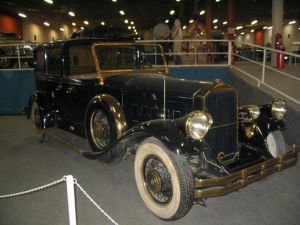- Home
- About Us
- Join/Renew
- Member Benefits
- Member Pages
- Log In
- Help
- Museum Store
Message deleted by original poster
This is how the car looks today, dirty whitewalls and all. It is not known if the car is currently running.

Hi Curtiss,
Excuse me if you can for being a smarty pants, but the car does not have gold plated chrome, it has gold plated brightwork.
The gold plated brightwork is most likely gold over nickel so that the base metal (steel) does not contaminate the gold plating bath.
Because I had the brightwork on my Series 80 re-plated, I came to understand the process for plating is: copper over steel, nickel over copper, and if need be for you chrome guys, chrome over nickel.
Apparently, chrome will not stick to copper and nickel seems to have the correct metallurgical properties to hold chrome.
BTW, I jumped in on this one because it is a slow day here at the Psychology Ranch in Olde Massachusetts.
Finally, it is an interesting story and I wonder if once completed there was a competition to “out do” the Shah of Persia’s Pierce-Arrow?
Rather than calling that one–upmanship sort of sport “Healthy Competition,” one might call it “Wealthy Competition.”
Peter
It was said the Maharaja of India had a Pierce-Arrow touring car built that succeeded the cost of the Shah’s car. I used to have a photograph of it, but it has been lost over time.
I was at a dinner with Raymond Dietrich when he was asked what was the most expensive car ever built. His reply was the 1930 Shah of Persian Pierce-Arrow.
To add a bit to Peter’s description:
Copper is plated over steel because copper is soft, and will fill minor scratches and blemishes in the steel. The copper plating is buffed off the high areas, leaving a layer of copper in the low areas. Several layers are plated on, and buffed off until the surface is as perfect as possible.
Nickel is actually the ‘color’ or bright surface for Chrome Plating. Nickel CAN be plated directly on steel, but is much harder to buff off. Nickel plating will highlight any flaws in the underlying surface, so it has to be near-perfect. Nickel does tarnish, so it needs regular polishing to stay bright.
Chrome is nearly clear, it is actually a bit blue or black. Chrome is the plating equivalent of ‘Clear-coat’ for paint. The layer of Chrome over Nickel seals the Nickel and prevents tarnishing and dulling. But Chrome alone will not be bright unless it is plated over Nickel
If you put a polished Nickel’d part next to a Chromed part, you can easily see the color difference. Chrome is blue-black, and Nickel is a slightly below or gold shade. Chrome looks ‘cold’, Nickel has a ‘warm’ glow.
An interesting tid-bit about chrome: it is so shiny and bright, one would think that it is a perfect reflector, but that is not correct. Chrome only reflects about 60-65% of light. I made the mistake of having my headlight reflectors chromed on my first early car. The chromed headlights were rather dim. I later read that light reflectors should be plated in Silver. Silver is around 95% reflective of light. But it tarnishes. NASA used Silver on the telescope mirrors for the satellites sent into space. A ceramic or glass layer was applied over the Silver to seal it from darkening with tarnish.
A company named Uvira, which I believe is still around, offered this ceramic or glass coating over Silver for headlight and taillight reflectors.
If i have made errors in the above text, whomever is in the ‘know’, please add a comment so we all can learn.
Greg Long
Greg, you are 99.9% correct in your description! The only thing I believe incorrect is that Uvira puts and aluminum/glass coating over NICKEL plating.
You must send them your reflectors already nickel plated.
As a side note, I believe the owner of this business is not in the best of health, I sure hope someone continues this service if he gets to the point he can’t handle it….
Interesting thread. I recall visiting the local GM plant, Guide Div., back in the mid 1970s. The plant made sealed-beam headlamps before plastic took over. The automated gas flames which were used to fuse the lens to the body were interesting, and I recall the vacuum chamber in which a tiny aluminum wire was vaporized by a high current to form the reflective surface on the inside of the body of the lamp. It’s getting iffy to find sealed-beam lamps in the usual parts outlets now; I hope they don’t run out. I suppose someone will build a functional substitute with modern internals if/when necessary, though.
